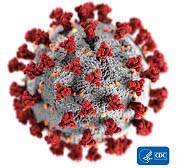Click here to subscribe today or Login.
WILKES-BARRE — The Pennsylvania Department of Health on Thursday reported 10 new confirmed cases of COVID-19 in Luzerne County and 1 new death.
Those numbers bring the total cases to 2,477 and the death toll to 124.
On Wednesday, there were 2,467 cases reported in Luzerne County.
In Lackawanna County, there are now 1,256 confirmed cases and 135 deaths; in Monroe County, there are 1,240 cases and 69 deaths.
The Department of Health confirmed that there are 938 additional positive cases of COVID-19, bringing the statewide total to 59,636. All 67 counties in Pennsylvania have cases of COVID-19.
Today, the state is reporting 4,218 total deaths, an increase from the 3,943 total deaths reported yesterday. There were 44 new deaths reported overnight; the remaining 231 were reported as a result of a reconciliation of data over the past several weeks. This means the department added 275 total deaths to the data.
In nursing and personal care homes, there are 12,677 resident cases of COVID-19, and 1,922 cases among employees, for a total of 14,599 at 549 distinct facilities in 44 counties. Out of our total deaths, 2,896 have occurred in residents from nursing or personal care facilities.
• In 19 unidentified Luzerne County nursing homes, there were 395 cases among residents and 66 staff cases. The report shows 91 have died in nursing homes in the county.
Approximately 4,217 of our total cases are in health care workers.
“As counties move from red to yellow, we need all Pennsylvanians to continue to follow the social distancing and mitigation efforts in place,” said Secretary of Health Dr. Rachel Levine. “We must continue to protect our most vulnerable Pennsylvanians, which includes our seniors, those with underlying health issues, our healthcare workers and our first responders. I am proud of the work that Pennsylvanians have done so far, but we cannot stop now, we must continue to take the necessary steps to protect ourselves from COVID-19.”
There are 251,559 patients who have tested negative to date. Of the patients who have tested positive to date the age breakdown is as follows:
Nearly 1% are aged 0-4;
Nearly 1% are aged 5-12;
Nearly 2% are aged 13-18;
Nearly 6% are aged 19-24;
Nearly 37% are aged 25-49;
Nearly 26% are aged 50-64; and
28% are aged 65 or older.
Most of the patients hospitalized are aged 65 or older, and most of the deaths have occurred in patients 65 or older.
For the latest information for individuals, families, businesses and schools, visit “Responding to COVID-19” on pa.gov.
Non-life-sustaining businesses in the red phase are ordered to be closed and schools are closed statewide through the remainder of the academic year. Currently, 24 counties are in the yellow phase of reopening; 13 more will move to the yellow phase on May 15.
Today, Governor Tom Wolf released an updated Carnegie Mellon University (CMU) Risk-Based Decision Support Tool report for May 12. The administration has released two previous reports based on public data on May 1 and May 8.
“Beginning today, we will post this CMU report twice weekly to allow Pennsylvanians to see the information produced by this tool. This information contributes to our process which enables us to make informed, data-driven decision about reopening the state,” Wolf said.
The commonwealth is partnering with CMU to create this data-driven decision support tool that enables a balance between maximizing the results of our economy while minimizing public health risks.
Qualitative and quantitative factors are taken into account in any decision made by the commonwealth and this tool provides one input the decision-making process. It helps the commonwealth better understand the current health and economic status, as well as the inherent risks and benefits to easing restrictions by sector and region.
The CMU metrics look at the impacts of risk factors such as reported number of COVID cases per population of an area; ICU and medical/surgical bed capacity; population density; population over age 60; and re-opening contact risk, such as the number of workers employed in a currently closed industry sector. The administration will continue to work with CMU to refine the tool as more information and data are available.
The CMU metrics are considered along with the county’s or region’s ability to conduct testing and contact-tracing to first and foremost maintain robust public health as well other economic factors.
Reach Bill O’Boyle at 570-991-6118 or on Twitter @TLBillOBoyle.





